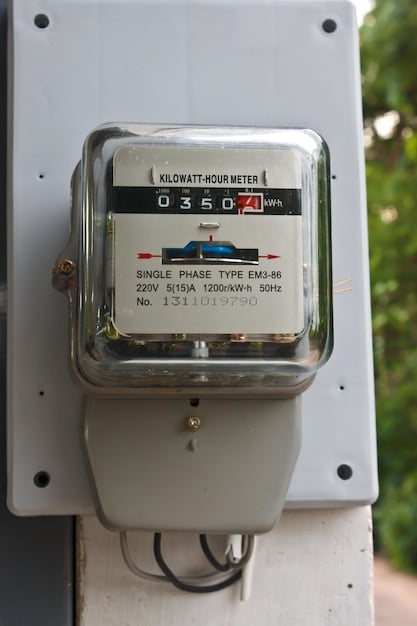Renewable Energy Tariffs: Your 2025 Guide to Cost Navigation

Understanding Renewable Energy Tariffs: A 2025 Guide to Navigating Costs delves into the evolving landscape of renewable energy pricing, providing clarity on various tariff structures, incentives, and strategies to optimize energy costs in a sustainable manner, ensuring both environmental responsibility and economic benefits for consumers and businesses in the U.S.
Navigating the world of energy can be complex, especially when you’re trying to make environmentally conscious choices. Understanding Renewable Energy Tariffs: A 2025 Guide to Navigating Costs offers a comprehensive look at how you can understand and potentially lower the costs associated with renewable energy.
What are Renewable Energy Tariffs?
Renewable energy tariffs are pricing structures that determine how much you pay for electricity generated from renewable sources like solar, wind, and hydro. These tariffs are designed to encourage the adoption of green energy by making it economically viable for consumers and businesses.
Understanding these tariffs is crucial for anyone looking to reduce their carbon footprint and potentially save money on their electricity bills. As we move towards 2025, the landscape of renewable energy tariffs is becoming increasingly complex, with various options available to suit different needs and preferences.
Types of Renewable Energy Tariffs
There are several types of renewable energy tariffs available in the U.S., each with its own set of benefits and drawbacks. Here are some of the most common ones:
- Feed-in Tariffs: These tariffs pay you for the renewable energy you generate and send back to the grid.
- Net Metering: This allows you to offset your electricity consumption with the energy you produce, with any excess being credited to your account.
- Time-of-Use Tariffs: These charge different rates based on the time of day, encouraging you to use energy during off-peak hours when renewable energy is more readily available.
- Community Solar Tariffs: These allow you to subscribe to a share of a solar farm and receive credits on your electricity bill based on the energy generated.
Choosing the right tariff depends on your energy consumption patterns, location, and the availability of renewable energy resources in your area. It’s essential to compare different options and understand the terms and conditions before making a decision.

In conclusion, renewable energy tariffs are essential tools for promoting the use of green energy. By understanding the different types of tariffs and how they work, consumers and businesses can make informed decisions that benefit both their wallets and the environment.
Factors Influencing Renewable Energy Tariff Costs
Several factors influence the costs associated with renewable energy tariffs. These factors can vary by location, energy provider, and the specific type of renewable energy source.
Understanding these factors is key to predicting and managing the costs of your renewable energy plan. Here’s a closer look at some of the most significant influences:
The Impact of Location
Your geographic location plays a significant role in determining the cost of renewable energy. Areas with abundant sunlight or wind resources, for example, may have lower renewable energy prices due to the increased availability of these resources.
Government Incentives and Policies
Government incentives and policies can significantly impact the cost of renewable energy. Tax credits, rebates, and other financial incentives can make renewable energy more affordable for consumers and businesses.
Renewable Portfolio Standards (RPS) require utilities to source a certain percentage of their electricity from renewable sources, which can drive up demand and potentially increase prices.
Technology and Infrastructure
The cost of renewable energy technologies, such as solar panels and wind turbines, can influence the overall cost of renewable energy tariffs. As technology improves and becomes more efficient, the cost of renewable energy can decrease.
- Grid infrastructure: Adequate grid infrastructure is necessary to transport renewable energy from where it’s generated to where it’s needed. Investments in grid infrastructure can impact the cost of renewable energy.
- Storage solutions: The availability of energy storage solutions, such as batteries, can also influence the cost of renewable energy. Storage solutions can help to address the intermittency of renewable energy sources, making them more reliable and potentially reducing costs.

In summary, several factors influence the costs associated with renewable energy tariffs. By understanding these factors, consumers and businesses can better navigate the renewable energy landscape and make informed decisions about their energy consumption.
Navigating Net Metering and Feed-in Tariffs
Net metering and feed-in tariffs are two common mechanisms used to incentivize renewable energy adoption. Both allow consumers and businesses to receive credit for the excess renewable energy they generate and send back to the grid, but they operate differently.
Understanding the nuances of these programs is crucial for maximizing the financial benefits of your renewable energy system. Here’s a closer look at each:
Net Metering
Net metering allows you to offset your electricity consumption with the energy you produce from your renewable energy system. When your system generates more electricity than you consume, the excess is sent back to the grid, and you receive a credit on your electricity bill.
The credit is typically calculated based on the retail rate of electricity, meaning you receive the same price for the energy you send back to the grid as you would pay for the energy you consume.
Feed-in Tariffs
Feed-in tariffs, on the other hand, pay you a fixed rate for all the renewable energy you generate, regardless of whether you consume it or send it back to the grid. The rate is typically higher than the retail rate of electricity to provide a greater incentive for renewable energy adoption.
Feed-in tariffs are less common in the U.S. compared to net metering, but they can be more financially attractive for some renewable energy system owners.
- Eligibility: Check the eligibility requirements for net metering or feed-in tariff programs in your area.
- Rates: Compare the rates offered under each program to determine which one provides the best financial return.
- Terms and conditions: Understand the terms and conditions of each program, including any limitations on system size or eligibility criteria.
In conclusion, net metering and feed-in tariffs are valuable tools for promoting renewable energy adoption. By understanding how these programs work and comparing the available options, consumers and businesses can make informed decisions that maximize the financial benefits of their renewable energy systems.
Time-of-Use Tariffs Explained
Time-of-use (TOU) tariffs are designed to reflect the actual cost of electricity at different times of the day and encourage consumers to shift their energy consumption to off-peak hours when electricity is cheaper and more readily available from renewable sources.
These tariffs can be a great way to save money and support the integration of renewable energy into the grid, but they require a good understanding of your energy consumption patterns.
How Time-of-Use Tariffs Work
Under a TOU tariff, the price of electricity varies depending on the time of day, day of the week, and sometimes even the season. Peak hours, when demand is highest, typically have the highest prices, while off-peak hours have the lowest prices.
By shifting your energy consumption to off-peak hours, you can take advantage of lower prices and reduce your electricity bill. This can be as simple as running your dishwasher or washing machine during off-peak hours or charging your electric vehicle overnight.
Benefits of Time-of-Use Tariffs
- Cost savings: Shifting your energy consumption to off-peak hours can result in significant cost savings on your electricity bill.
- Environmental benefits: By using electricity during off-peak hours, you can help to reduce demand during peak hours, which often rely on fossil fuel-based power plants. This can help to reduce greenhouse gas emissions and promote the use of renewable energy.
- Grid stability: TOU tariffs can help to stabilize the electricity grid by encouraging consumers to shift their energy consumption to times when renewable energy is more readily available.
In summary, time-of-use tariffs are a valuable tool for promoting energy conservation and supporting the integration of renewable energy into the grid. By understanding how these tariffs work and adjusting your energy consumption patterns, you can save money and help the environment.
Community Solar Programs and Tariffs
Community solar programs offer an alternative way to access solar energy for those who cannot install solar panels on their own roofs. These programs allow you to subscribe to a share of a solar farm and receive credits on your electricity bill based on the energy generated by your share.
Community solar is a great option for renters, apartment dwellers, and anyone who doesn’t have a suitable roof for solar panels.
How Community Solar Works
Under a community solar program, a solar farm is built in a central location, and individuals and businesses can subscribe to a share of the farm. The energy generated by the solar farm is fed into the grid, and subscribers receive credits on their electricity bills based on their share of the farm’s output.
You typically pay a monthly fee for your subscription, but the credits you receive on your electricity bill should more than offset the fee, resulting in overall cost savings.
Benefits of Community Solar
- Accessibility: Community solar makes solar energy accessible to those who cannot install solar panels on their own roofs.
- Cost savings: Community solar can result in cost savings on your electricity bill, especially in areas with high solar energy potential.
- Environmental benefits: By subscribing to a community solar program, you can support the development of renewable energy and reduce your carbon footprint.
In conclusion, community solar programs offer a convenient and cost-effective way to access solar energy for those who cannot install solar panels on their own roofs. By subscribing to a community solar program, you can save money and support the development of renewable energy.
Future Trends in Renewable Energy Tariffs for 2025
As we look ahead to 2025, several trends are shaping the future of renewable energy tariffs, including advancements in technology, changes in government policy, and evolving consumer preferences.
Understanding these trends is crucial for staying ahead of the curve and making informed decisions about your energy consumption.
Technological Advancements
Advancements in technology are driving down the cost of renewable energy and making it more efficient. This is leading to lower renewable energy tariffs and greater adoption of renewable energy sources.
Energy storage technologies, such as batteries, are also improving, making it easier to store and dispatch renewable energy when it’s needed. This is helping to address the intermittency of renewable energy sources and make them more reliable.
Policy Changes
Government policies are playing a key role in promoting the adoption of renewable energy. Tax credits, rebates, and other financial incentives are making renewable energy more affordable for consumers and businesses.
Renewable Portfolio Standards (RPS) are requiring utilities to source a certain percentage of their electricity from renewable sources, which is driving up demand and lowering costs.
Evolving Consumer Preferences
Consumers are increasingly demanding renewable energy options and are willing to pay a premium for green energy. This is driving utilities to offer more renewable energy tariffs and to invest in renewable energy infrastructure.
As technology advances, government policies evolve, and consumer preferences shift, renewable energy tariffs are becoming more affordable, accessible, and attractive. By staying informed about these trends, you can make the right choice.
| Key Aspect | Brief Description |
|---|---|
| 💡 Types of Tariffs | Includes feed-in, net metering, time-of-use, and community solar options. |
| 🌎 Location Impact | Geographic location affects the cost due to resource availability and policies. |
| 💰 Government Incentives | Tax credits and rebates can drastically reduce renewable energy costs. |
| ⚡ Future Trends | Advancements in technology, policy changes, and consumer demand are key. |
FAQ
▼
Renewable energy tariffs reduce your carbon footprint, support sustainable energy development, and can lower long-term energy costs. They also provide energy independence and hedge against fossil fuel price volatility.
▼
Net metering allows you to offset your electricity consumption with the energy you generate from renewable sources. Excess energy sent back to the grid earns you credits on your electricity bill.
▼
Consider your energy consumption patterns, geographic location, available renewable resources, government incentives, and the specific terms and conditions of the tariff options available to you.
▼
Initially, they might seem pricier, but considering long-term savings, government incentives, and the declining cost of renewable tech, these tariffs can be economically competitive and offer greater price stability.
▼
Community solar provides access to solar energy for those without suitable roofs, promotes renewable energy development, reduces carbon footprint and offers potential cost savings by sharing solar farm benefits.
Conclusion
Understanding renewable energy tariffs is essential for navigating the evolving energy landscape in 2025. By exploring different tariff structures, considering influencing factors, and staying informed about future trends, consumers and businesses can make informed decisions that benefit both their wallets and the environment. Embrace the power of renewable energy and take control of your energy costs today.





